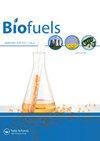利用常压冷等离子体射流流体动力学反应器从葵花油中生产生物柴油
IF 2.6
4区 工程技术
Q3 ENERGY & FUELS
引用次数: 2
摘要
摘要传统的酯交换工艺耗时且成本高昂。新方法,如非热等离子体技术,减少了反应时间和温度。因此,本研究旨在评估等离子体射流-流体动力学组合反应器在酯交换反应中的应用。本研究中使用的等离子体射流包括一个带有中心高压电极和环形外电极的陶瓷管,其中通入氩气。流体动力学反应器由一个在其环境中有孔的转子组成,该转子在固定定子中旋转。在本研究中,等离子体射流评价的操作参数包括甲醇与油的摩尔比(4:1、6:1、8:1)、催化剂浓度(0.75、1.25 wt.%)和反应时间(30、60和90 s) 。用于评估流体动力学反应器的操作参数包括反应时间(30、60和90 s) ,反应温度(40、50和60 °C),以及转子-定子距离(10、20和30 mm)。采用响应面法(RSM)和Box-Behnken设计对结果进行分析和优化。根据结果,单独使用等离子体射流产生83%的转化率。最后,对该产品的物理和化学特性进行了评估,发现其不符合国际标准。本文章由计算机程序翻译,如有差异,请以英文原文为准。
Biodiesel production from sunflower oil using a combined atmospheric cold plasma jet-hydrodynamic reactor
Abstract Conventional transesterification processes are time-consuming and costly. New methods, such as non-thermal plasma technology, reduce the reaction time and temperature. Therefore, this study aims to evaluate the use of a combined plasma jet–hydrodynamic reactor for transesterification. The plasma jet used in this research comprised a ceramic tube with a central high-voltage electrode and a ring outer electrode, into which argon gas was fed. The hydrodynamic reactor consisted of a rotor with holes in its environment that rotated in a fixed stator. In this study, the operating parameters for plasma jet evaluation include the molar ratio of methanol to oil (4:1, 6:1, 8:1), catalyst concentration (0.75, 1, 1.25 wt.%), and reaction time (30, 60, and 90 s). The operating parameters for evaluating the hydrodynamic reactor included reaction time (30, 60, and 90 s), reaction temperature (40, 50, and 60 °C), and rotor–stator distance (10, 20, and 30 mm). The response surface method (RSM) and Box–Behnken design were used to analyze and optimize the results. According to the results, using a plasma jet alone produces a conversion percentage of 83%. Finally, the product’s physical and chemical characteristics were evaluated, and it was found to be insufficiently compliant with international standards.
求助全文
通过发布文献求助,成功后即可免费获取论文全文。
去求助
来源期刊

Biofuels-Uk
Energy-Renewable Energy, Sustainability and the Environment
CiteScore
5.40
自引率
9.50%
发文量
56
期刊介绍:
Current energy systems need a vast transformation to meet the key demands of the 21st century: reduced environmental impact, economic viability and efficiency. An essential part of this energy revolution is bioenergy.
The movement towards widespread implementation of first generation biofuels is still in its infancy, requiring continued evaluation and improvement to be fully realised. Problems with current bioenergy strategies, for example competition over land use for food crops, do not yet have satisfactory solutions. The second generation of biofuels, based around cellulosic ethanol, are now in development and are opening up new possibilities for future energy generation. Recent advances in genetics have pioneered research into designer fuels and sources such as algae have been revealed as untapped bioenergy resources.
As global energy requirements change and grow, it is crucial that all aspects of the bioenergy production process are streamlined and improved, from the design of more efficient biorefineries to research into biohydrogen as an energy carrier. Current energy infrastructures need to be adapted and changed to fulfil the promises of biomass for power generation.
Biofuels provides a forum for all stakeholders in the bioenergy sector, featuring review articles, original research, commentaries, news, research and development spotlights, interviews with key opinion leaders and much more, with a view to establishing an international community of bioenergy communication.
As biofuel research continues at an unprecedented rate, the development of new feedstocks and improvements in bioenergy production processes provide the key to the transformation of biomass into a global energy resource. With the twin threats of climate change and depleted fossil fuel reserves looming, it is vitally important that research communities are mobilized to fully realize the potential of bioenergy.
 求助内容:
求助内容: 应助结果提醒方式:
应助结果提醒方式:


